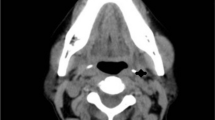Abstract
Eagle’s Syndrome (ES) refers to a symptomatic anomaly due to elongation of the styloid process or mineralization of the styloid complex. If not diagnosed timely and treated properly, elongation of the styloid process or the hyper-mineralization of the stylohyoid ligament may eventually lead to complete ossification of the stylohyoid complex. Non-specific head and neck symptoms of the ES may pose diagnostic challenges to the clinician. Therefore it is crucial to include ES among differential diagnosis when evaluating patients with similar head and neck symptoms. Once the diagnosis is confirmed, treatment plan should be tailored in accordance with the individual requirements of the case and performed without delay. Both pharmacological and surgical methods have been described for the treatment of the patients with ES. However for those who suffer from persistent symptoms, surgical removal of the elongated styloid process is the treatment of choice and can be done with an intraoral or an extraoral approach. The aim of this work is to present unusual clinical symptoms and radiologic findings of ES due to complete ossification of the stylohyoid complex. The importance of a correct diagnosis and appropriate treatment are highlighted.





Similar content being viewed by others
References
More CB, Asrani MK. Eagle’s syndrome: report of three cases. Indian J Otolaryngol Head Neck Surg. 2011;63(4):396–9.
Fusco DJ, Asteraki S, Spetzler RF. Eagle’s syndrome: embryology, anatomy, and clinical management. Acta Neurochir (Wien). 2012;154(7):1119–26.
Bensoussan Y, Letourneau-Guillon L, Ayad T. A typical presentation of Eagle syndrome with hypoglossal nerve palsy and Horner syndrome. Head Neck. 2014;36(12):E136–8.
Han MK, Kim do W, Yang JY. Non surgical treatment of Eagle’s syndrome: a case report. Korean J Pain. 2013;26(2):169–72.
Mendelsohn AH, Berke GS, Chhetri DK. Heterogeneity in the clinical presentation of Eagle’s syndrome. Otolaryngol Head Neck Surg. 2006;134(3):389–93.
Keur JJ, Campbell JP, McCarthy JF, Ralph WJ. The clinical significance of the elongated styloid process. Oral Surg Oral Med Oral Pathol. 1986;61(4):399–404.
Eagle WW. Elongated styloid process; symptoms and treatment. AMA Arch Otolaryngol. 1958;67(2):172–6.
Moon CS, Lee BS, Kwon YD, Choi BJ, Lee JW, Lee HW, Yun SU, Ohe JY. Eagle’s syndrome: a case report. J Korean Assoc Oral Maxillofac Surg. 2014;40(1):43–7.
Murthy PS, Hazarika P, Mathai M, Kumar A, Kamath MP. Elongated styloid process: an overview. Int J Oral Maxillofac Surg. 1990;19(4):230–1.
Beder E, Ozgursoy OB. Karatayli Ozgursoy S. Current diagnosis and transoral surgical treatment of Eagle’s syndrome. J Oral Maxillofac Surg. 2005;63(12):1742–5.
Jaju PP, Suvarna V, Parikh NJ. Eagle’s syndrome: an enigma to dentists. J Indian Acad Oral Med Radiol. 2007;19(3):424–9.
Strauss M, Zohar Y, Laurian N. Elongated styloid process syndrome: intraoral versus external approach for styloid surgery. Laryngoscope. 1985;95(8):976–9.
Diamond LH, Cottrell DA, Hunter MJ, Papageorge M. Eagle’s syndrome: a report of 4 patients treated using a modified extraoral approach. J Oral Maxillofac Surg. 2001;59(12):1420–6.
Torres AC, Guerrero JS, Silva HC. A modified transoral approach for carotid artery type Eagle syndrome: technique and outcomes. Ann Otol Rhinol Laryngol. 2014;123(12):831–4.
Acknowledgments
Dr. Baur is a paid consultant for Novartis Pharmaceuticals and Checkpoint LLC and Dr. Altay has provided consultancy for Checkpoint Surgical LLC in 2014. Other authors disclose no financial or personal relationships with other people or organizations. There was no grant support for this study. The final version of the manuscript has been seen and approved by all authors.
Author information
Authors and Affiliations
Corresponding author
Rights and permissions
About this article
Cite this article
Elimairi, I., Baur, D.A., Altay, M.A. et al. Eagle’s Syndrome. Head and Neck Pathol 9, 492–495 (2015). https://doi.org/10.1007/s12105-014-0599-4
Received:
Accepted:
Published:
Issue Date:
DOI: https://doi.org/10.1007/s12105-014-0599-4




